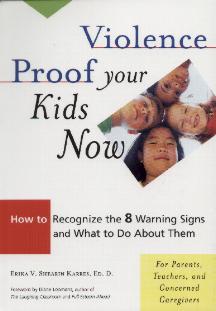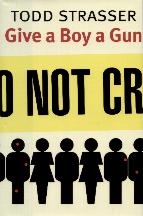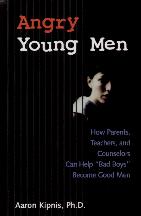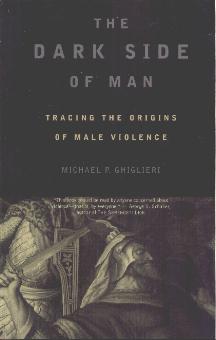Menstuff® has compiled information, books and resources on the issue of violence.
|
|
|||||
 |
 |
 |
 |
 |
|
It’s not about mental illness:
The big lie that always follows mass shootings by white
males
Violence
against women—it's a men's issue - Video 19:07
![]()
These Are the Most Dangerous States to
Live in as a Woman
PIXABLE DATA: These Are The Most Dangerous
States In America To Be A Woman
Violence Tax
Use a Gun, No More Fun
56 Times in 81 Seconds
Bad Girls - Women's
Violence
Modeling Non-Violent
Behavior
Road Rangers
Abusive
Behaviors
Sticks and
Stones - and School Yard Killings
Gender Bias Okayed by Circuit
Court
Teens at Risk
Violent Victimization Rates by Sex,
1973-98
When Victimization becomes
Invisible
Does the Sex of the
Perpetrator Matter?
Snapshots of Children's Exposure to
Community Violence
Anatomy
Of A One Punch Knockout
KSU expert says male
college students also victims of violence at girlfriends’
hands
Relationship Violence
Common in College
Newsbytes
Related Issues - Talking With
Kids About Tough Issues, Abuse
- Ritual, Abuse - Sexual,
Bullies, Bullying,
Bullying Girls, Circumcision,
Cyberbullying, Domestic
Violence, Hazing, Online
Harrassment, Prisons, Sexual
Harassment, Teacher's Pet,
TV Violence, Violent
Girls, Chic Fights, Womens'
Violence, Really Bad Women,
Women who Sexually Abuse
Children, and Teacher's Pet
Books - Related topics of Abuse
- Boys, Abuse -
Children, Abuse -
Ritual, Abuse -
Sexual, Circumcision,
Anger,
Domestic
Violence, Sexual
Violence, Sexual
Harassment,, Women's Violence,
Violence
Journals
- Emotional and Sexual Abuse and Trauma
Alternatives
to Violence programs
Q&A Slide Guide on Gangs
Here is a list of all the Measure 11 crimes and how long you will stay in prison if you are found guilty. No probation! No parole! No early release! Just prison. (Yrs/Mos):
Think first! Remember, no probation, no parole, no
early release! Just prison.
Knowing that it is becoming increasingly difficult to prevent a child from being exposed to violence through media and outside the home, the campaign reminds that the earliest and strongest influencers of children are parents, caregivers and teachers.
The campaign's ad messages remind parents and other caregivers that their everyday actions and reactions are teaching ever-observant children to deal with life and it's obstacles in either positive or problematic ways.
Viewers are invited to visit the web site or call the organization to help them develop specific skills for positive role modeling and violence prevention.
The campaign is funded by the MetLife Foundation, and was originally launched in 2001. New work was released in July 2005.
Sponsor Organization: American Psychological
Association, National Association for the Education of Young
Children, MetLife Foundation Web Site: www.actagainstviolence.org
![]() or or call 1-877-ACT-WISE or www.adcouncil.org/default.aspx?id=53
or or call 1-877-ACT-WISE or www.adcouncil.org/default.aspx?id=53
![]()
![]() 56 Times in 81 Seconds (ich
schleigh umher betrubt)
56 Times in 81 Seconds (ich
schleigh umher betrubt)
Sticks and Stones
and School Yard Killings
We can blame it on the availability of guns, or movies, television or war toys as innocent as GI Joe. We can even point, in this case, at Goth. But in doing that, I suggest we look where our other three fingers are pointing and take responsibility for the part we played in this scenario. Yes, all of us. For, you see, I think the problem goes much deeper that what the newspapers or "expert" psychologist are saying. The problem lies within virtually every home in America. While the solution may be more difficult, I think problem is very simple.
Name calling. Feeling insecure in our selves, or developing a dislike or even hate of people who are different from us (race, religion, sexual preference, and the hate list goes on), we start by passing on jokes that malign others, then name calling behind someone's back, then finally to their face. Names beyond the many raciest names we all know.
These killers in Littleton, Colorado weren't athletes, or pep squad leaders, or the popular kids at school. The "killers" at the previous school killings weren't either. But those are the people they targeted. And, I think, they just got tired of being called weirdo's, nerds, geeks, freaks, stupid, slobs, or whatever words the in-crowd uses to attack someone's self-esteem. After a while, these young men can't deal with it anymore and return the attack in the only way they can see that will stop the abuse.
The message they are sending is "Stop calling me names" and no one is listening. So, the name-calling and ridicule continue. And the communities involved start focusing on an action plan and gun control and fences around the schools and more security checks, more shakedowns, and the list goes on. While short-term those may be necessary, they are only short-term solutions.
We all must get actively involved with this problem. Really look at all the ways each of us becomes a perpetrator. Then, start teaching our children about the dangers of name calling and the importance of developing respect for everyone, especially those who are different in some way than we are. Outside the home by standing up and saying "Stop calling him (or her) names" or "I don't think that joke is funny" or "Stop sending me those emails." In school, send the name callers to the principles office.
As an adult, "Sticks and stones may break my bones, but names will never hurt me." But as a kid who doesn't "fit in," or look the part, or isn't as popular as "Joe cool," names not only hurt, they kill.
Possible Solutions
It can get frustrating as a parent or non-parent knowing what to do. And, while there are a number of good books and how to work to reduce teen violence, cultural violence and the shadow violence that lurks without each of us, many of us won't go to the effort of getting one of these books to start the work now.
In the meantime, the following are some steps you can take to stop violence among young children, from Parenting for Peace & Justice:
Speak out to your family, friends, and co-workers to develop an awareness of the "accepted" violence among teens and children, including name calling, insults, pushing, shoving and kicking.
Support conflict-resolution programs in your home, school and community to help children (and adults) learn now to solve problems without resorting to violence (hitting, kicking, throwing something, slamming doors, phones, pencils, etc.).
Volunteer in parent education classes or as a "resource parent" for young teen and first-time parents to help participants parent without resorting to violence. Volunteer for the teen crisis line, if you really want to get a reality check about what's happening to the youth in your community! If you're man enough, that is.
Help your children select nonviolent toys, television programs and movies. DON'T BUY WAR TOYS!!! Read books to your children that promote peaceful conflict resolution.
Speak out against movies and television programs that glamorize violence or make it funny. TV Violence
Lead by example. Children learn more from our actions than our
words. (Don't Laugh at
Me.)
Gender Bias Okayed by Circuit Court
Violent Victimization rates by Sex,
1973-98
1973 48.5 68.0 31.4
1974 49.1 69.4 31.3
1975 48.9 66.8 33.1
1976 48.5 65.8 33.3
1977 50.5 71.1 32.4
1978 50.2 70.0 32.8
1979 51.5 69.7 35.3
1980 49.4 68.1 33.0
1981 52.6 70.9 36.5
1982 51.0 66.9 36.9
1983 46.2 61.7 32.4
1984 46.2 60.6 33.4
1985 44.7 59.5 31.6
1986 41.9 54.3 30.9
1987 43.7 56.8 32.0
1988 44.2 55.0 34.4
1989 43.4 56.8 31.4
1990 44.0 57.6 32.0
1991 48.0 64.5 33.4
1992 47.8 59.3 37.2
1993 49.9 59.8 40.7
1994 51.8 61.1 43.0
1995 46.6 55.7 38.1
1996 42.0 49.9 34.6
1997 39.2 45.8 33.0
1998 36.6 43.1 30.4
National Crime Victimization Survey: 1973-1991
data adjusted to make data comparable to data after the redesign.
Homicide data were calculated from the FBI's Supplementary Homicide
Reports.
Snapshots of Children's Exposure to Community Violence
Global Move To Scale Up Response To
Violence
Fear on Campus: The Problem and Prevalence
of Stalking
![]() Violence in Baseball Emulates Hockey
Violence in Baseball Emulates Hockey
 2.
2.  3.
3. 
The WHO Violence Report: Does
the Sex of the Perpetrator Matter?
But some persons have taken issue with this conclusion. They argue that since men are more likely to be the perpetrators of violence, then isn't the emphasis on female victimization justified? In other words, shouldn't male-on-male violence be less worrisome than male-on-female violence?
Our response is that we believe the sex of the perpetrator is irrelevant to the issue. Consider these questions:
1. Mothers are more likely than fathers to abuse their children. When daughters are being harmed, should society be less worried about that because it represents female-on-female abuse?
2. In almost all cases, the persons who abduct infants from hospitals are female. When a woman abucts a baby girl from the hospital, is that less of a concern then when a woman robs a baby boy?
3. Several recent books reveal that up to one-quarter of all lesbian relationships are affected by domestic violence (2-4). Should victims of lesbian partner aggression be ignored because they have have been involved in female-on-female violence?
4. In Africa, the practitioners of female genital mutilation are female. Does that fact make female genital mutilation a less gruesome procedure?
We believe the answer to all four questions is "No." Our compassion for the victim of abuse, aggression, or violence should not be diminished by the gender, race, or any other characteristic of the perpetrator. A person who has been harmed by violence warrants our concern, regardless of the sex of the person who caused the injury.
So we come back to the assumption implicit in the WHO Report that male victims of violence deserve less attention and services than female victims -- doesn't this represent a pernicious example of a gender double-standard?
Contact Information: Etienne Krug, World Health Organization, Department of Injuries and Violence Prevention, 20 Avenue Appia, CH-1211 Geneva 27, Switzerland. Call + 41 (22) 791 3480 or Fax + 41 (22) 791 4332. Cost of first-class postage from the United States: 80 cents
References
1. Men's Health America. The WHO Violence Report: When Victimization Becomes Invisible. October 17, 2002. groups.yahoo.com/group/ menshealth/message/596.
2. Girshick LB. Woman to woman sexual violence: Does she call it rape? Boston: Northeastern University Press, 2002.
3. Kaschack E (editor). Intimate betrayal: Domestic violence in lesbian relationships. Haworth, 2002.
4. Ristock I. No more secrets: Violence in lesbian relationships.
Routledge, 2002.
Super Bowl Bound
Ravens Afraid to Play the Best
Sibling violence may have serious
consequences
Health groups link media to child
violence
And in one of the most definitive statements yet on violence in American culture, four national health associations link the violence in television, music, video games and movies to increasing violence among children.
"Its effects are measurable and long-lasting," the four groups say in a statement. "Moreover, prolonged viewing of media violence can lead to emotional desensitization toward violence in real life."
The joint statement by the American Medical Association, the American Academy of Pediatrics, the American Psychological Association and the American Academy of Child and Adolescent Psychiatry was to be the centerpiece of a public health summit Wednesday on entertainment violence.
"The conclusion of the public health community, based on over 30 years of research, is that viewing entertainment violence can lead to increases in aggressive attitudes, values and behaviors, particularly in children," the organizations' statement says.
Advocating a code of conduct for the entire entertainment industry, Sen. Sam Brownback, a Republican, compared the statement to the medical community declaring that cigarettes can cause cancer.
"I think this is an important turning point," said Brownback. "Among the professional community, there's no longer any doubt about this. For the first time, you have the four major medical and psychiatric associations coming together and stately flatly that violence in entertainment has a direct effect on violence in our children."
The Motion Picture Association of America and the National Association of Broadcasters refused to comment Tuesday on the medical associations' statement.
The four health professional groups left no doubt about their feelings in the statement:
--"Children who see a lot of violence are more likely to view violence as an effective way of settling conflicts. Children exposed to violence are more likely to assume that acts of violence are acceptable behavior," it said.
--"Viewing violence can lead to emotional desensitization toward violence in real life. It can decrease the likelihood that one will take action on behalf of a victim when violence occurs."
--"Viewing violence may lead to real-life violence. Children exposed to violent programming at a young age have a higher tendency for violent and aggressive behavior later in life than children who are not so exposed."
Brownback said he hopes the statement will convince lawmakers that something has to be done about media violence. And, "I hope parents will look at this and say that they're going to have to police their children's entertainment violence content the same way they police what their children eat and other health issues."
One entertainment violence monitoring group, The Lion and Lamb Project in nearby Bethesda, Maryland, cheered the statement.
"Right now, the message we're sending children in the media is that violence is OK ... that it's part of life and sometimes it's even funny," executive director Daphne White said. "We're even using violence for humor now."
Jeff Bobeck, a spokesman for the National Association of Broadcasters, said television now has V-chips and a rating system to help parents take control of what their children watch. "We think more parents need to control their remote control," Bobeck said.
But White said the entertainment industry markets video games and toys to children based on R-rated movies, has increased the violence in movies and shows that are rated for children and even previewed adult-oriented movies during children's G-rated movies. "The industry has been actively marketing adult stuff to children while saying it's the adults' fault," she said.
On the Net: Motion Picture Association of America: www.mpaa.org/
National Association of Broadcasters: www.nab.org/
The Lion and the Lamb Project: www.lionlamb.org/
Sen. Sam Brownback: brownback.senate.gov/
![]()
![]() Bobby Knight - How Contrite - Good Night!
Bobby Knight - How Contrite - Good Night!
In his 330 word statement he said he was "trying" to control his
emotions. Emotions are okay, in fact encouraged. He needs to
understand the difference between emotions and control his otherwise
out-of-control behavior. He said he needed to be more diplomatic.
What he needs is 26-52 weeks in an alternatives to violence program.
And, he needs to stop "trying" to do it and "Do it". Coaches
strangling players. Players strangling coaches. Maybe we should just
turn off the TV and wait until these athletes can get it together, if
they want to, and then see if we can enjoy sharing a basketball with
our kids again, sans Bobby Knight.
Remember That You are your child's primary role model. If you carry a gun, you could send your kid the message that guns solve disputes. (Sony Brings You: Dropping Bombs on Your Moms.)
These Are the Most Dangerous States
to Live in as a Woman
According to the National Coalition Against Domestic Violence, a
woman is assaulted in the U.S. every nine seconds.
As if this statistic isn't daunting enough on its own, approximately one third of American women will be sexually assaulted in their lifetime.
To put this data in perspective, that's one out of every three women you know — be it your sister, daughter, mother, or friend.
While this information is exclusive to sexual assault incidents, the truth is that violence against women is pervasive in many different ways as well as areas.
Across the U.S., women face different levels of threats that vary based on the states where they live. Here's a compilation of data from the FBI, the National Intimate Partner and Violence Survey, and the U.S. Census Bureau on the most dangerous places for women in the U.S. from the years 2010-2023.
See below for 10 states with the largest percentage of women who said they were raped in their lifetime.
1. Alaska (21%)
2. Oregon (21%)
3. Michigan (20%)
4. Nevada (18.8%)
5. New Hampshire (18.7%)
6. Oklahoma (18.6%)
7. Washington (18%)
8. Colorado (18%)
9. Minnesota (16.9%
10. Connecticut (16.9 %)
See below for 10 states where women are most frequently sexually assaulted.
1. Oregon (43.3%)
2. Alaska (42%)
3. Maryland (41.9%)
4. New Hampshire (40.8%)
5. Washington (40.5%)
6. Illinois (38.6%)
7. North Carolina (38.3%)
8. New York (38%)
9. Connecticut (37.2%)
10. Kentucky (36.8%)
Read the full report here for more statistics and to see the infographic.
PIXABLE DATA: These Are The Most Dangerous
States In America To Be A Woman
The true scope of how many women have been attacked or victimized, especially by people they know, is terrifying. What’s even more terrifying is everything we don’t know. The last published results of the National Intimate Partner and Violence Survey are from 2010.
The closest we could get to finding real, recent answers on the frequency of sexual assault and rape in the last couple of years is from the FBI. The legal definition of rape was recently changed to include both male and female victims, but the FBI still includes statistics of the legacy definition (female victims only) in their annual crime report. We expected the FBI’s crime report to more or less match the figures from the CDC’s 2010 survey, but we noticed a drastically low number of rape victims — roughly 26 women per 100,000 people.
That’s when we realized a key fact. The FBI is basing their figures on arrests and convictions, excluding statutory rape and incest and only documenting “forcible rape.” The sad truth is that most rapes go unreported — with forcible rapes making up only a fraction of all reported rapes — and even less rapists are actually convicted. According to RAINN less than half of all rapes are reported, only 12% of what is reported actually leads to an arrest and only 3% of rapists see punishment for their actions.
When it comes to violence against women, not every zip code is equal, and some places are more dangerous than others. We’ve examined statistics from the FBI, the CDC’s 2010 comprehensive National Intimate Partner And Violence Survey and the U.S. Census Bureau to narrow down the most dangerous places for women in the United States from 2010 – 2014.
One out every six women in the U.S.A. was a victim of an attempted or completed rape in 2010.
(Source: Pixable / Mariel Loveland)
Places like Alaska and Oregon hold the highest rates of rape against women, whereas states like Virginia and California hold some of the lowest rates. The 2014 information from the FBI also shows a different perspective than that of the above statistics from the CDC. While many of the same states are still on the top 10 list, some new states appear as well. This could be for a number of reasons. There could have been an increase or decrease in crime in the last four years among certain states or some states could just have a higher rate of conviction due to differing justice systems.
The 10 states with the largest percentage of women in 2010 who said they were raped in their lifetime are:
1. Alaska (21%)
2. Oregon (21%)
3. Michigan (20%)
4. Nevada (18.8%)
5. New Hampshire (18.7%)
6. Oklahoma (18.6%)
7. Washington (18%)
8. Colorado (18%)
9. Minnesota (16.9%
10. Connecticut (16.9 %)
In 2014, These were the states with the most rapes per 100,000 according to the FBI
1. Alaska (75.3)
2. New Mexico (51.4)
3. South Dakota (48.4)
4. Montana (42)
5. Michigan (40.9)
6. Arkansas (39.8)
7. Colorado (39.6)
8. North Dakota (37.3)
9. Kansas (37)
10. Arizona (36.6)
Sexual crimes against women (other than rape) are even more commonplace. These results from the 2010 CDC report are eye-opening.
(Source: Pixable / Mariel Loveland)
At the lowest rate, which occurs in Louisiana, 22% of women have experienced sexual violence other than rape. Most states fall somewhere between the 30 and 35% mark, while others like Oregon see 43% of women falling victim to non-rape sexual violence. The 10 states where women are most frequently sexually assaulted are:
1. Oregon (43.3%)
2. Alaska (42%)
3. Maryland (41.9%)
4. New Hampshire (40.8%)
5. Washington (40.5%)
6. Illinois (38.6%)
7. North Carolina (38.3%)
8. New York (38%)
9. Connecticut (37.2%)
10. Kentucky (36.8%)
One of the most obvious ways to determine if a place is dangerous is by looking at the murder rate. The murder rate for females in 2010 was notably higher in certain states.
(Source: Pixable / Mariel Loveland)
States in the southern half of the United States have a notably higher murder rate among females than states in the northern half. Southern states also have looser gun laws.
According to the CDC, in 2010, the states with the most murders per 100,000 people are:
1. Louisiana (4.44)
2. Mississippi (4.13)
3. Alabama (3.85)
4. New Mexico (3.69)
5. South Carolina (3.57)
6. Arkansas (3.48)
7. Nevada (3.48)
8. Georgia (3.32)
9. Tennessee (3.1)
10. North Carolina (3.07)
Stalking doesn’t always lead to violence, but it can. Even still, stalking is far less common than sexual assault but worth mentioning. This is the percentage of women in 2010 who reported having been stalked in their lifetimes.
(Source: Pixable / Mariel Loveland)
In Kentucky, the state with the highest percent of incidents, 19% of women report being stalked. Most states see an 11-13% rate of stalking, while the states with the lowest instances, Wisconsin and Virginia, see a rate of 9.8% and 8.6% respectively. The states with the highest percentage of women who have been stalked are:
1. Kentucky (19%)
2. Alabama (18.4%)
3. Nevada (17.7%)
4. Oklahoma (16.6%)
5. New Mexico (16.4%)
6. North Carolina (16%)
7. Tennessee (15.3%)
8. Wyoming (15.2%)
9. Mississippi (15.1%)
10. Pennsylvania (15%)
Four out of every five assaults are committed by someone the victim already knows (a friend, boyfriend, acquaintance, etc), and one third of women are assaulted by an intimate partner. The 2010 report shows the sheer number of women who reported being assaulted by an intimate partner within their lifetimes.
(Source: Pixable / Mariel Loveland)
Considering 94% of women who are murdered and four fifths of women who are raped are attacked by someone they know, these statistics are particularly telling. These states have the highest percentage of women who have been raped, physically assaulted, or stalked by an intimate partner.
1. Oklahoma (36.8%)
2. Nevada (34.8%)
3. North Carolina (33%)
4. Michigan (32.5%)
5. Washington (32.4%)
6. Maryland (32%)
7. New Hampshire (32%)
8. Alaska (32%)
9. South Carolina (31.7%)
10. Tennessee (30.6%)
When labeling the most dangerous places for women, it may also be important to consider a woman’s mental health. A cluster of states seem to have had a notably higher suicide rate between 2004 and 2010.
If the attack is on oneself, versus a homicide or physical assault from another party, does it still count? Regardless of genetic predisposition to depression and self-harm, situations that lead a woman to suicide are perhaps indicators of an unhealthy environment.
(Source: Pixable / Mariel Loveland)
States with highest rates of suicide per 100,000 people are:
1. Alaska (9.62)
2. Nevada (9..62)
3. Wyoming (8.19)
4. New Mexico (8.06)
5. Montana (7.96)
6. Colorado (7.76)
7. Oregon (7.23)
8. Arizona (7.18)
9. Florida (6.40)
10. Idaho (6.31)
The problem is still growing, which is why we need more information.
Despite the most comprehensive and accurate report being from 2010, the frequency of rape among women has not decreased. According to the FBI, the figures rose 1.6% between 2013 and 2014. This leads us to the question, why isn’t there a more recent CDC study on domestic abuse if the problem is growing? How many women will really be assaulted (sexually or otherwise) in their lifetimes? How many women were actually affected within the last year alone and didn’t report it to the police?
Perhaps if people are more aware of the massive scale of the problem, it could help lead to a change. For every woman who says it can never happen to me, who truly believes it’s only a problem for a few unfortunate people, there is another woman who understands that it can happen to anyone and it does happen to anyone, even if she remains silent in her understanding.
There is help out there for women who find themselves in trouble.
If you need help and you’re in the U.S., call 1-800-799-SAFE
(7233) for the National Domestic Violence Hotline or 1-800-656-HOPE
(4673) for the National Sexual Assault Hotline.
Source: www.pixable.com/article/the-most-dangerous-states-in-america-to-be-a-woman-69100?t_cat=84&utm_medium=partner&utm_source=facebook&utm_campaign=mtv&xrs=_s.fb_main
![]()
O! it is excellent to have a giant's strength; but it is tyrannous to use it like a giant. - William Shakespeare